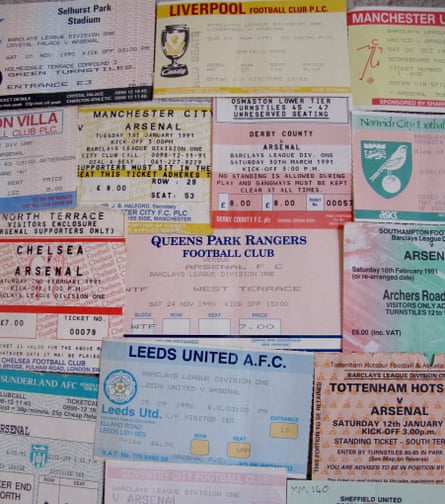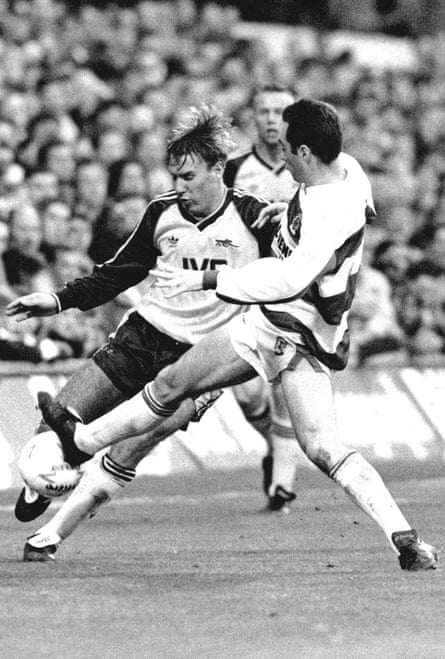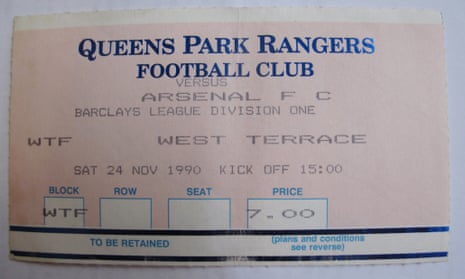Examining a ticket for a football match that took place 25 years ago in the light of the £5.136bn super-figure that forces us to confront the price of football, how perfect to see the block I stood in for £7 all those years ago at Loftus Road was called “WTF”. If we had known then what we know now about spiralling matchday costs and acronyms, no doubt that would have been our thoughts exactly.
What a day to dig out a footballing time capsule. The announcement of the Premier League’s latest gazillions coincided with my discovery of a stash of old tickets and programmes which pre-dated the big boom. In the 1990-91 season I had the pleasure of attending a match at every top division ground, and scanning through the memorabilia, it was a reminder of how affordable football was, if you will pardon the expression, no big deal.

As the First Division was preparing to morph into the Premier League, a time when clubs were responding to the Taylor Report recommendations and in the process of replacing terraces with seats, £7-a-game was round about average. It made top-flight football accessible to most. Even as a teenager without a job, it was not extravagant to attend more than 45 matches over the season in league and cups.
By my unscientific calculations (considering the different match categories these days and variation of what different clubs charge, £40 is an approximate average) attending every league game comes in at around £1,500 for tickets only nowadays, compared to £260 during the 1990-91 campaign. There is inflation to be taken into account, naturally, but even so £7 would be £15.20 in today’s money.
Looking back, of course, the early 90s was a halcyon age. I was 19, with a shambolic haircut, a mind full of unrealistic ideas, a second-hand VW Polo, a load of lovingly made mix tapes and a cheap football ticket in my pocket. The highway to football was our oyster. It wasn’t all glamour – the police welcomes, and the shacks that passed for ladies’ toilets with a group of semi-apologetic gentlemen with desperate bladders relieving themselves against the walls are not exactly missed – but it was brilliantly easy going to football more or less as often as you liked.
It was only a fiver to stand at Old Trafford’s Scoreboard Paddock. Southampton’s Archers Road Terrace was £6. Same at Kenilworth Road and Elland Road. Chelsea, Norwich, Coventry, Queens Park Rangers and a perch at Roker Park were a bit more pricey at £7. I got seats for a few matches – Villa Park, Maine Road and the Baseball Ground came in at £8. A seat in the Anfield Road end at Liverpool was the steepest ticket that year, setting me back £9. It looks like a quirk, incidentally, that the kick-off time printed on all of the tickets is 3pm.

The much-needed discussion about redistribution of some of the Premier League’s £5bn windfall is a meaningful one. Although Richard Scudamore, the chief executive, insists that the Premier League is not a charity, it is pertinent to recognise that it also would not exist without grassroots football to be a nursery for the players of the future, and fans to provide the special effects required for the product that sells so well for TV. If you have endured a broadcast of a behind-closed-doors game it is not hard to imagine how television companies would view the whole thing rather differently without this essential part of the package. Elite football without fans both looks and sounds weird.
But for the majority of supporters, keeping up with the explosive finances in the game is an ongoing struggle. It is common for a season ticket to be shared amongst friends or family. Away games, especially with awkward kick-off times for long distance travellers, are immensely challenging.
The Football Supporters’ Federation have been campaigning with its “Twenty’s Plenty” idea, setting a reasonable maximum for away fans. With the additional money pouring forth, the game should be pressed to go further, with home tickets also capped. “Thirty-five keeps support alive”? The slogan needs a bit of work, obviously, but you get the idea. Leaving aside corporate tickets for clubs to set as they please, a cap on the price of a regular ticket should be on the agenda.
The average age of Premier League supporters is now over 40. Our teenagers – the ones the game needs to be our season-ticket holders of the future – can’t possibly afford to cement their commitment to football by gallivanting around the country to games every week.
It’s not charity anybody is after. It’s a fair price that the Premier League can well afford to impose.

Comments (…)
Sign in or create your Guardian account to join the discussion